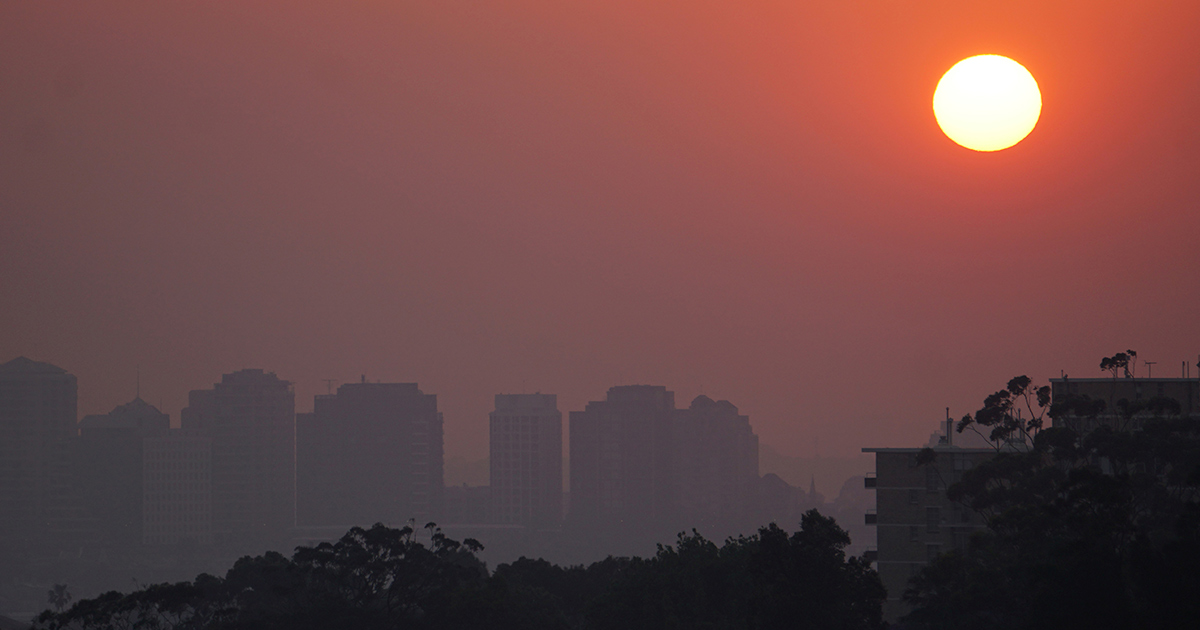Australia is burning: causes, data and fake news on the bushfire situation

According to the latest estimates of January 8, we have witnessed 10.7 million hectares covered by fire. This area is equal to Valle d'Aosta, Piedmont, Liguria, Lombardy, Trentino, Veneto, Friuli Venezia Giulia and half Emilia Romagna combined. Protected areas were not spared from the flames, such as the UNSECO site, Wollemi National Park and Kangaroo Island.
In two months, over 6,000 buildings have been destroyed, including 2,000 homes. More than 100,000 people have been internally displaced while 28 people have lost their lives due to the fires. The dense of smoke, with yellow and red hues, has made the air unbreathable. While the preliminary estimates on the affected on fauna will make you shiver. We need to better understand and reduce the smoke on data, images, causes and news chasing each one another in these days.
The current situation
For comparison, the fires of 2019 wiped out 900,000 hectares of the Amazon and 4.5 million hectares in Siberia. Therefore, it is clear that in Australia we are talking about fires that have already devastated an area equal to twice the bonfires that stunned public opinion in 2019. Unfortunately, we are only at the beginning of the Australian summer, which ends in late February.
With as many as 10.7 million hectares covered by fire, one must be careful to say, "Australia is on fire". Fortunately, this is not the case, as so far the fire has "only" covered 1.4% of the entire Australian territory, which is equal to 769 million hectares. Contributing to this false perception was the image published on Instagram by a Brisbane graphic designer, Anthony Hearsey. At first glance, the image looks as if it could have been a shot from space, viewing Australia dotted with fires. In reality, Hearsey used satellite data collected by NASA's FIRMS system to create a 3D rendering, called an infographic that shows the sum of all the fires that have developed in the last month. To further this, not only does the image summarize all the fires of the last month in one shot the image does not include those fires that have already been extinguished. Rather the author himself declared that the dimensions used of single fires have been enlarged to increase the glow effect. Therefore, it is an artistic representation of the data and not the reality, neither of the current nor of the past.
Was it a record year?
The current states where fires are found are in New South Wales, Queensland, Western Australia, Victoria and South Australia.
Certainly, the most affected Australian state is New South Wales with 4.9 million hectares burned, 20 reported deaths and over 1600 homes destroyed. Historically speaking if we are considering this particular state, then yes we are facing a record year of fires. The worst seasons that New South Wales had recorded was the summer of 1974-75 and that of 1984-85, with 4.5 million hectares and 3.5 million hectares burned respectively.
Fortunately, from a global perspective, we are far from the worst fires season that Australia has seen. Between the spring and summer of 1974-1975 over 100 million hectares burned, that’s equal to 14% of the entire country.
However, the Gospers Mountain Fires seems to challenge all past reports. Caused by lightning, these fires have spread to over 500,000 hectares of bush fire since October. Burning the land that is covered by the typical barren Australian savannah environment of grass and shrubs. According to Ross Bradstock, of the University of Wollongong, this could be the largest single fire ever recorded.
To stay updated on the situation in Australian, and that of fires reported globally, the most reliable site is Global Forest Watch Fires. Just enter the time interval, even the single day, and the area of interest to view clear graphics, air quality, and much more.
Why do fires seem unstoppable?
Let's start with some details, how do we measure the speed of fire dissemination and the dimensions to where they reach? Fires run, fast, faster than a professional marathoner who can do about ten kilometres per hour. Bush fires can travel at a speed of about 22 km / h and spreads among the eucalyptus foliage at about 11 km / h. This the first obstacle in dealing with fires that can quickly get out of control. In some areas, the flames can reach 70 meters in height and with the power equal to 100,000 kW per linear meter. In these conditions, extinguishing a fire is almost impossible. Aeroplane and helicopters have difficulty flying due to poor visibility and therefore throwing water or retarding agents become quite a difficulty. While ground vehicles with firefighters cannot operate because the concentration of flames is too powerful, equal to an intensity of 4000 kW per linear meter.
What causes this?
The cause and blame are varied. Starting with natural events, in particular lightning and intense winds. Wind turbines that fall due to gusts at over 100 km / h triggering the fuse that start some fires. Sadly, many other fires are attributable to human error and deliberately set fires. In this case, bots and trolls spread false arson claims. The case in Australia is that the so-called "arsonists on the loose" is in reality very different.
While it is true that court proceedings have been launched against 183 people accused, but not arrested, in various capacities of having committed forest fire crimes between New South Wales, Victoria and Queensland. However, according to The Guardian, this number is a hodgepodge of data that in large part has nothing to do with the current fire season. In short, it is a number that makes little sense. Just to give an example, 43 out of 183 are people accused in the state of Victoria between September 2018 and September 2019, obviously have nothing to do with the current fires. Labelling these people as arsonists are inaccurate as most are just careless and poorly informed people about the danger of fires. Throwing cigarette butts or matches on the ground, not respect the ban on campfires or personal waste incineration. Of the famous 183, only 24 have been arrested for intentionally setting fires this season in New South Wales. In short, the first cause of ignition is lightning, followed by the carelessness of poorly informed people, and only in a very small part is there an arsonist involved.
What causes the fires to flare up in this way?
Whatever the spark was, it is clear that the fires spread quickly and on a large scale, but why? Just look at the map drawn up by the Australian Bureau of Meteorology to get a better understanding of the areas devastated by flames in the past 34 months, January 2017 to October 2019. These lands have suffered from extreme droughtas Australia has seen a 40% drop in rainfall in the last 12 months.
When taking into account the data related to temperature, wind speed, humidity and drought, the McArthur Forest Fire Danger Index was well above the average in most of the country in December of 2019. For the rest, the risk was the highest ever recorded compared to any month since registrations began in 1950.
The abnormal heat of the last month, with a monthly average of 42 ° C and peaks of 49 ° C, has dried up the vegetation, providing the ideal conditions for the perfect fire. While strong wind then acts as an oxidiser by raising the flames and allowing them to spread more effectively.
As if that wasn’t bad enough, the biggest fires feed each other at an even greater distance. The hot air generated by the fires, together with smoke and ash, rises to the top, cools, and then this intense humidity forms vertically unstable storm clouds. These unstable clouds, called pyro-cumulonimbus clouds, can transport hot ashes over very large areas, generating lightning and thus triggering new fires. In short, it is a dog that bites its tail. Add to all this, we must note that the hot and intense winds can give rise to fire whirls, small tornadoes of fire.
What does climate change have to do with it?
We can say that in the past 70 years the average annual temperatures have risen by about 1.5 ° C in Australia and that 2019 has been the hottest and driest year since 1910. In short, the country of koalas and kangaroos is becoming increasingly hot and dry. One thing that may not be too surprising, but for Australia, there is one another factor that has come into play.
The Indian Ocean Dipole (IOD), also known as the Indian Niño, is an irregular oscillation of the surface temperature of the Indian Ocean, whereby its western part becomes warmer, or colder, than the eastern part. This year the dipole has been positive and the temperature difference between the east and west areas of the Indian Ocean has been one of the most marked in the past 60 years. Which means that the IOD has caused above-average rainfall and flooding in East Africa. This has led to drought and extreme heat in Southeast Asia, including Australia. Climate change, the rise of the Earth's temperature, also interferes with the dipole cycle of the Indian Ocean. This means that events like this could soon triple in regularity. In short, climate change creates the ideal conditions for events of this type to become ever more frequent and disastrous. Finally, according to NASA data, the fires of recent months in Australia have released about 350 million tons of CO2. Australian fires are contributing to the global climate crisis.
Haven’t there always been fires in Australia?
Yes, of course, Australian history has always been littered with fires, as reported here. The eucalyptus forests and the bushfires, the Australian landscape is largely vegetation born of fire. Including species that rely on fire to release their seeds, others to germinate, and others are resinous in substance that contain highly flammable oils taking advantage of the passing fires. Even animals such as kangaroos benefit from fires, for example, the soft grass that grows after fires for which they feed.
Fire is part of the Australian ecosystem, similar to that of the Mediterranean bush know well here in Italy. The ecosystem regenerates, but it takes time, and there may be less and less time to regenerate between one fire and another due to climate change. Moreover, a 2009 report by the Australian government admitted candidly. That “by 2020, extreme fire danger days in south-eastern Australia may occur 5 to 65 per cent more often than at present and a 2°C increase in mean annual temperature would increase fire intensity by 25%, increase the area burnt, and halve the mean interval between fires in the Australian Capital Territory (ACT)”.
How many animals died, and are koalas at risk of extinction?
According to estimates made by the ecologist Chris Dickman of the University of Sydney, about 800 million animalshave died from fires since early September, including land mammals, birds and reptiles. His previous estimate, predicted when there were 7 rather than 10 hectares burned, amounted to 480 million animals. These calculations exclude bats, amphibians, fish, and invertebrates. However, Dickman did not count the animals that died; rather his calculations tell us "how many animals could have been victims of the fires". Dickman has estimated the density of mammals, birds and reptiles per hectare in New South Wales, collected from data in 2007, has multiplied this density by the area covered by fire. In addition to not taking into account bats, amphibians and invertebrates, the estimate does not take into account animal mobility, as animals such as kangaroos, emus and birds can more easily escape the flames. However, this does not mean that the animals who managed to survive the fire and smoke couldn’t also die in the coming weeks due to the scarcity of food, shelters, or exposer to predators. While other native species, there are 300 endemic mammals in Australia, could see a large part of their habitat wiped out.
As for koalas, there are estimates of 8,000 dead koalas, about a third of those in New South Wales. Fortunately, according to the International Union for Conservation of Nature (IUCN), there are at least 100,000 koalas in Australia, with some estimates of 300,000, making a more precise estimate is difficult, but enough to be on the verge of extinction. The koalas, however, are not doing well and classified as "vulnerable" by the IUCN. In 20 years, 1990-2010, the national population has decreased by 28%, due to massive deforestation, increasingly frequent heatwaves, fires and extreme drought, but also from the increase in foreign and domestic species. In short, without being unnecessary alarmists, they need concrete action to save them from the brink of extinction.
There are still issues to clarify by conservative Australian politics, pointing to the extraction of coal and by not complying with the Paris agreements. Prime Minister, Scott Morrison, is a constant denier of climate change, is challenged by the amount of water used to distinguish the fire since Australia is largely deserts and covered by arid grasslands. The real anguish, however, lies in the fact that the Australian southern summer began on the first of December and will last until the end of February. In short, the balance sheet is far from being definitive, and the damage will be marked in the coming decades.









